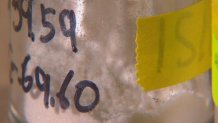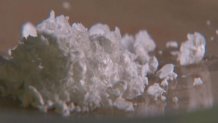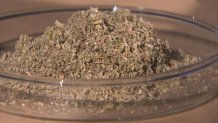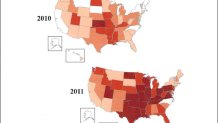White Lady, Mr. Nice Guy, Sour D and Plur.
With their shiny packaging and intriguing names, it's hard for some to take them seriously. But for Jill Head, those little packets may be the scariest thing she's seen go through her lab.
"I want people to know that there is no association to these drugs with marijuana,” she told the News4 I-Team. “I've heard words like ‘legal weed’ or ‘synthetic marijuana’ but these are scarily misleading."
Head and her team of forensic chemists work at the Drug Enforcement Administration's Special Testing and Research Laboratory in Virginia. They analyze and identify all of the suspected drugs seized by DEA agents throughout the world.
Before 2009, the chemists there said they typically saw only about a half-dozen types of illicit drugs like cocaine, heroin, meth and marijuana. But since then, they've been flooded with more than 300 varieties of synthetic drugs, Head said.

"This is a really strange phenomenon, the speed,” Head said. “Probably at the highest we've been seeing one to two synthetic drugs per week."
Local
Washington, D.C., Maryland and Virginia local news, events and information
She then pulled out two small vials filled with white powder.
One, labeled JWH-018, is one of the very first samples seized by the DEA in 2009. The other appeared in 2013 and is called AB-Fubinaca. To the naked eye, they both look identical to cocaine.

Head explained all the synthetic drugs they’ve seen start out as white powders manufactured in Chinese laboratories. “Bath salts, Flakka, Spice, Scooby Snax, Molly. They all look like this. They're all powders."
The DEA groups synthetics by what they look like under a microscope.
One group, called MDMA, is typically sold under the brand name Molly or Ecstasy and stays in powder form or gets pressed into a pill.
Bath salts and Flakka are part of the “substituted cathinones” class and have a crystal-like appearance. The DEA said they’ve noticed in the past year that many people who think they’re taking Molly are actually taking something more closely related to bath salts.
The DEA said most of the shiny packets seized by their agents and local police are in yet another class called “synthetic cannabinoids.”
Head showed how the plant leaves contained with the packets get dosed with the white powder, rendering it invisible to the naked eye. “What happens is the drug, in this case AB-Fubinaca, is added to a chemical solution and dissolved. The way you would dissolve sugar into ice tea. You make a solution, and it's added to the plant material.”

DEA agents have uncovered industrial-size mixing operations, Head said. “There's various methods for mixing, such as spraying or mixing it in a bathtub or in a cement mixer."
She explained the mixing is often uneven, creating “hotspots” the DEA believes may be leading to some overdoses. Some people get a batch with little or no chemicals on the leaves. Others get highly concentrated does.
Head then pulled out some of the earliest packets she and her team analyzed in 2009 and 2010. They look crudely assembled compared to their more modern counterparts, advertising K2 and Spice, two brand names “we don’t really see a lot of anymore,” Head said.
Another early brand name, Scooby Snax, is still widely available, according to Head. But she warned the label on the outside has nothing to do with the chemicals she's found inside. "We can analyze one and it will have one drug in it, even from the same store, the same seizure, right next to it will have a completely different drug."
The DEA cautions you shouldn’t be fooled by labels like "Fruit Punch," which promises it's "lab certified" with "no banned chemicals.” Or “D'Evil,” which claims it’s "cannabinoid free" and "DEA compliant."
Head said none of it's true. They’re all illegal synthetic drugs.
Which is why Head doesn't just analyze synthetic drugs -- she's one of the very few allowed to actually make them in the United States.
Her team has noticed some patterns in the way some drugs are made. Single atoms, for instance, are sometimes switched out in a predictable order.
"For example, we see the fluorine atom," Head told us. "We'll see this trend where there is a new drug and they add a fluorine atom. Then there is another new drug and they add a fluorine atom. So, there are trends in the synthesis in what we monitor that helps us predict what might come next.”
Head explained that by using these patterns and making new combinations that have not yet appeared in the United States, their lab can give the DEA a jump start on what's coming next in this new drug war.
"The scariest thing to me is how much is unknown and how much people don't know,” Head said. “They’re completely unknown. It's roulette."




